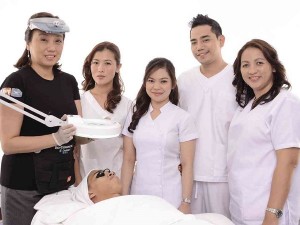
The aging population of baby boomers, the importance of image and the boom of medical aesthetics have spurred the growth of spas, skincare clinics and aesthetic centers in hospitals.
These have created the demand for aestheticians, licensed professionals who keep the skin in its best condition.
To help improve the standards in the local industry, American-licensed aesthetician Sylvia Cancio founded the country’s first professional school, La Manille School of Esthetics and Wellness.
She studied at Atelier Esthetique in New York, a school recognized by the International Therapy Exam Council in London (Itec). The nod from Itec affirms that its program provides uncompromising standards in aesthetics.
La Manille’s three-month course covers anatomy, with focus on the muscular and nervous system, physiology, electricity and lights, facial massages, botanicals, aromatherapy and business. They learn everything, from writing a resumé to watching the bottom-line.
To get a license, students need to pass written exams and practical exams on how to apply a European facial and Repechage, a French facial for mature skin.
Further, the hands-on exams include making a model of a head with the skin and the nerves, hair and glands and treating serious acne conditions. An aesthetician can restore the client’s skin to its original smooth condition without any medication.
Improve standards
“Aesthetics is a branch of anatomy that deals with the skin. We study as if you’re a doctor. The study covers 300 hours—more than what a doctor studies unless you’re a dermatologist who concentrates on skin diseases. I’m trying to establish something like Europe, which has skincare centers,” says Cancio. “There, you can’t touch anyone’s face unless you have a license. It’s very regulated.”
The training underscores the importance of sanitation. “Our book is very strict with terms. What is the difference between cleaning, disinfecting, sanitizing and sterilization? They can’t be interchanged.”

Students learn the international practices which are not often applied in some beauty centers here. Cancio cites a practice in some beauty salons and spas which is a no-no abroad: reusing paraffin wax. When clients get paraffin wax treatment on their hands, some salons put the wax back into the container after the treatment.
“Although germs can’t grow inside because of the heat, the wax has been used. Salons tend to recycle it. Since the person paid for the treatment, the wax should be disposed of.”
While some salons wipe the bed with alcohol, La Manille emphasizes clean linens and towels that have been washed separately. After usage, they should be kept in a closed hamper or bin to prevent bacteria from spreading.
Some places discard needles and soiled cotton in a trash can. In extractions, used needles need to be disposed of immediately, as with the gloves.
As a skin therapist, the aesthetician is trained in chemical exfoliation. “It’s a lighter peel, while doctors go deeper by using chemical peels,” says Cancio. The aesthetician applies an acid on the skin which makes it “scuff” or “crack” and gradually shed off for newer skin. The process allows other chemicals or correctives to penetrate deeply.
“When students go to school, they just don’t study peeling for its sake, but how to apply these correctives after the peel,” says Cancio.
Part of the training includes reading labels thoroughly and analyzing them. In the future, the aesthetician could inform the client why certain ingredients or preservatives create reactions or pose risks to clients.
“We follow the standards,” says Cancio. “We are strict with how we use words. There’s no such thing as permanent hair removal. It’s permanent hair reduction,” she says. The aesthetician must know the different stages of hair growth, how lasers can arrest the growth at a certain stage and why there is regrowth.
Likewise, they don’t use the term “sunblock.” “Nothing totally blocks the sun’s rays. The word is sunscreen or sun protection,” says Cancio.
In the Philippines, most centers and clinics learn to use machines and lasers from the salesman. Because an aesthetic clinic could invest an average of P1 million in its equipment, Cancio points out that it is important to have thorough understanding of electricity, lasers and how light responds to various skin colors.

Still, Cancio’s approach isn’t just rote learning. “I teach classes in reflection. What do you think about that? What went right? How do you feel?”
Microcurrent facial
Students apply theory in practice in La Manille’s signature two-hour facial.
“I used to think that facials were superficial. They are important in cleansing and exfoliation,” says Cancio. In keeping with the global standard, La Manille uses professional products.
“Our aestheticians need to analyze your skin, so they will use the right cleanser for your skin type. There is a massage that goes with the cleansing which stimulates circulation. This is followed by the exfoliation which removes dead skin cells. We use fine granules that roll around the skin. That’s why people glow after a facial. Then it’s the mask for acne or hydrating. Some want to relax, so we use green tea. Underneath is a serum which penetrates the deeper layers of the skin,” says Cancio.
La Manille pushes hydrodermabrasion more than microdermabrasion (commonly known as diamond peel.)
Microdermabrasion uses tiny rough grains of aluminum oxide bristle tips to peel off the topmost surface of the skin. However, the process can be drying. Hydrodermabrasion, on the other hand, unclogs pores and removes skin debris by using gentle pressure washes using water and oxygen. The skin is brightened up in the second pass.
After improving the skin tone, client undergoes the microcurrent treatment which targets facial muscles. The electrical stimulation uses tiny currents that can stimulate cells and promote healing of soft tissues.
The LED (light-emitting diode) light therapy caps the treatment. Wavelengths of light emitted from LEDs stimulate cellular activity to create collagen and elastin. Depending on the light, it can also address pigmentation, inflammation and acne. After the facial, clients report a general feeling of well-being, aside from brighter complexion.
Since La Manille opened in 2011, the school has had over 50 graduates, majority of them entrepreneurs. Five have passed the Itec exams and are qualified to work overseas such as in spas on luxury cruise ships. Recruitment agencies have been asking Cancio for graduates.
“When you graduate, you are on par with the rest of the world,” says Cancio.
La Manille School of Esthetics and Wellness will open its summer program on Monday. Located at 2240 Chino Roces Avenue, Makati City; tel. 8195881 and 0917-8922240









































